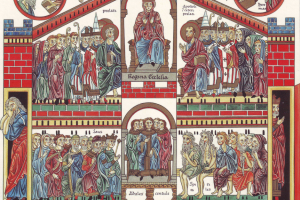When Sharon Lavigne was growing up in St. James Parish, Louisiana, her family had a garden and fruit trees. They had livestock, chickens, and fresh eggs. The air was clear, and the water was clean. “We lived a wonderful life, a healthy life. We didn’t even go to the doctor,” she says. “We didn’t have to go. We were healthy.”
Today, St. James Parish looks different. The town lies within Cancer Alley, a stretch of land along the Mississippi River that, within just 85 miles, houses more than 150 petrochemical plants and refineries. The area garnered its unfortunate name because of the increased risk of cancer its residents face due to the air and water pollution and other toxins created by the plants.
“We don’t see many people left in the fifth district where I’m from,” Lavigne says. “So many people have gone. So many people died earlier in life because of cancer, respiratory problems, and other illnesses. Our life expectancy used to be a lot longer than this.”
In 2018, Lavigne felt like she was at an impasse: People were dying around her, and her community was crumbling. “I couldn’t understand why I’ve been living here all my life, and I had to give up my home for industry,” she says. “I felt like they had taken over our community right before our eyes.”
A lifelong Catholic, Lavigne took to prayer to make sense of what was going on around her. She didn’t want to leave the only home she’d ever known, but it had become a matter of life and death. When she asked in prayer if she should sell her land, God told her no. “He told me to fight,” she says.
And just like that, the retired special education teacher, mother of six, and grandmother of 12 became a passionate advocate for ecological justice who hasn’t stopped working around the clock to save her community.
In the 1960s, chemical plants began building factories in St. James Parish and the surrounding area, promising to build up the community, be good neighbors, and provide well-paying jobs. “We thought that was something nice because we had industry in our little old town,” Lavigne says. “They made the picture so pretty that you thought it was going to be a wonderful thing, not knowing it would be poisoning you.”
Years passed, and more plants moved into the predominantly Black, lower-income area. They just kept coming because, Lavigne believes, “we brought the least resistance, and nobody could speak up.”
But by 2018, Lavigne had found her voice. She never thought she would do this type of work, but through her deep relationship with God, she felt called to begin Rise St. James, a faith-based grassroots organization fighting for ecological justice in St. James Parish.
“I had no intention of doing what I’m doing, but out of all the people in St. James Parish, God chose me,” she says. “I want to breathe clean air and drink clean water and make a garden again. That’s what I want, and I don’t think that’s too much to ask.”
Rise St. James—which now employs a small staff including Lavigne and two of her daughters as well as several dedicated volunteers—tirelessly lobbies community leaders to stop additional chemical and plastic plants from being permitted to come in and subsequently continue poisoning the population. The organization is small but scrappy and has seen success in a short amount of time.
Their first win came in 2019 when, after months of campaigning, Wanhua Chemical withdrew its $1.25 billion proposal to build a chemical plant in St. James Parish. In 2022, in partnership with Earthjustice—a nonprofit environmental law organization—they successfully blocked South Louisiana Methanol from building a multibillion dollar methanol complex, which had the potential to emit more than 2 million tons of greenhouse gasses per year.
Lavigne has made real change in her community. It’s challenging work, but she relies on her faith to keep her focused. “I have to pray,” she says. “That’s what keeps me motivated. We know God is working through us. And there’s a lot more that God wants us to do.”
As Rise St. James has found success, Lavigne has been recognized for her hard work and dedication. She won the Goldman Environmental Prize in 2021 and was recognized on the Forbes “50 over 50” impact list. In 2022, Lavigne received the University of Notre Dame’s Laetare Medal, which has also been awarded to John F. Kennedy, Dorothy Day, and President Joe Biden.
Lavigne hasn’t let the high honors and praise go to her head, though. She has too much work left to do. “Our organization is worthy of doing things to correct the situation that’s going on here,” she says. “I want the young people to stay here and live here. But they can’t if there is nothing here to offer them when the industry is poisoning the community.”
Her next step is to target the local leaders who are responsible for allowing chemical plants to come to the town. To Lavigne, these individuals are not leaders at all.
“My mission is to take them down,” she says. “They don’t care about our lives. All they care about is lining their pockets from industry. So they don’t need to be our leaders; they ought to be ashamed of themselves.”
Through everything Rise St. James has accomplished, the deepening of Lavigne’s relationship with God and her faith has been the most rewarding part. “I love being Catholic,” she says. “Through all this work, I got closer to God. That’s the best thing.”
Where is Cancer Alley?
Cancer Alley is in the River Parishes of Louisiana, an area between Baton Rouge and New Orleans that contains 150 petrochemical factories and plants within an 85-mile stretch. This area produces 25 percent of the petrochemicals in the United States.
Why is it called Cancer Alley?
The area’s moniker refers to the increased number of cancer diagnoses within the population compared to the rest of the country. It is estimated that 46 people per 1 million are at risk of developing cancer, versus 30 people per 1 million on average across the United States. According to a ProPublica analysis, the cancer risk in this area can be as high as 47 times the Environmental Protection Agency’s acceptable risk limit.
Who is most affected in Cancer Alley?
This area has been recognized by researchers and advocates as a prime example of ecological racism in the United States. Black people from the area are 16 percent more at risk of developing cancer than those in primarily white areas. In addition, the risk of cancer in low-income areas is 12 percent higher than higher-income areas.
This article also appears in the May 2023 issue of U.S. Catholic (Vol. 88, No. 5, pages 45-46). Click here to subscribe to the magazine.
Image: Wikimedia Commons













Add comment